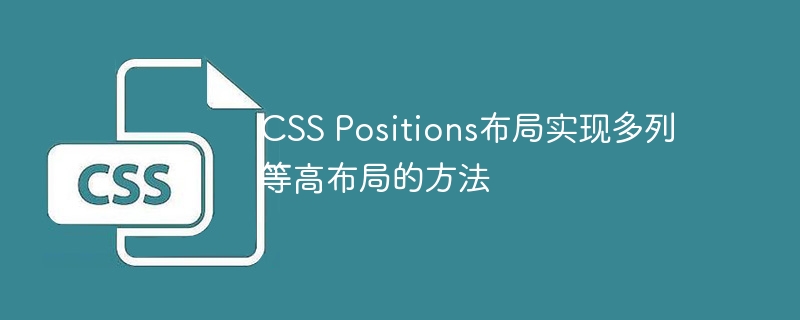

CSS Positions layout method to implement multi-column equal-height layout
In web development, implementing multi-column equal-height layout is a common requirement. The traditional method is to use JavaScript to implement it, but this method has compatibility and performance issues. Now we can achieve multi-column equal-height layout by using CSS Positions layout, which is not only easy to use, but also effective.
The key to achieving a multi-column equal-height layout is to set the height of the content column to be equal to the height of the tallest column. Below we introduce three common CSS Positions layout methods.
.flex-item {
flex: 1;
}
Using flex layout is the simplest way to achieve multi-column equal-height layout. We set the display attribute of the parent element to flex and the flex attribute of the child element to 1, so that the child elements will evenly distribute the width of the parent element and the height will automatically remain consistent.
.grid-item {
grid-column-start: span 1;
}
Multiple columns of equal height can also be achieved using grid layout layout. We set the display attribute of the parent element to grid, and then use the grid-template-columns attribute to define the width of the child element. Use repeat(auto-fit, minmax(...)) to automatically adapt to the width of the parent element, and set the grid-column-start attribute of the child element to specify the starting position of each column.
.column-item {
float: left;
width: 33.33%;
}
Using position and float layout can also achieve multi-column equal height layout. We set the overflow attribute to hidden for the parent element so that the float can be cleared. Then set the float attribute for the child element and the width ratio of the parent element, so that the child element will automatically float in one line and the height will automatically remain consistent.
It should be noted that the above methods all need to set the height of the parent element, and the content of the child element cannot exceed the height of the parent element, otherwise the effect of the equal height layout will be destroyed.
To sum up, it is very convenient to use CSS Positions layout to achieve multi-column equal height layout. We can choose to use flex layout, grid layout, or position and float layout to implement it, and choose the appropriate method according to our needs and preferences.
I hope this article will help you understand and apply CSS Positions layout to achieve multi-column equal height layout!
The above is the detailed content of CSS Positions layout method to implement multi-column equal height layout. For more information, please follow other related articles on the PHP Chinese website!